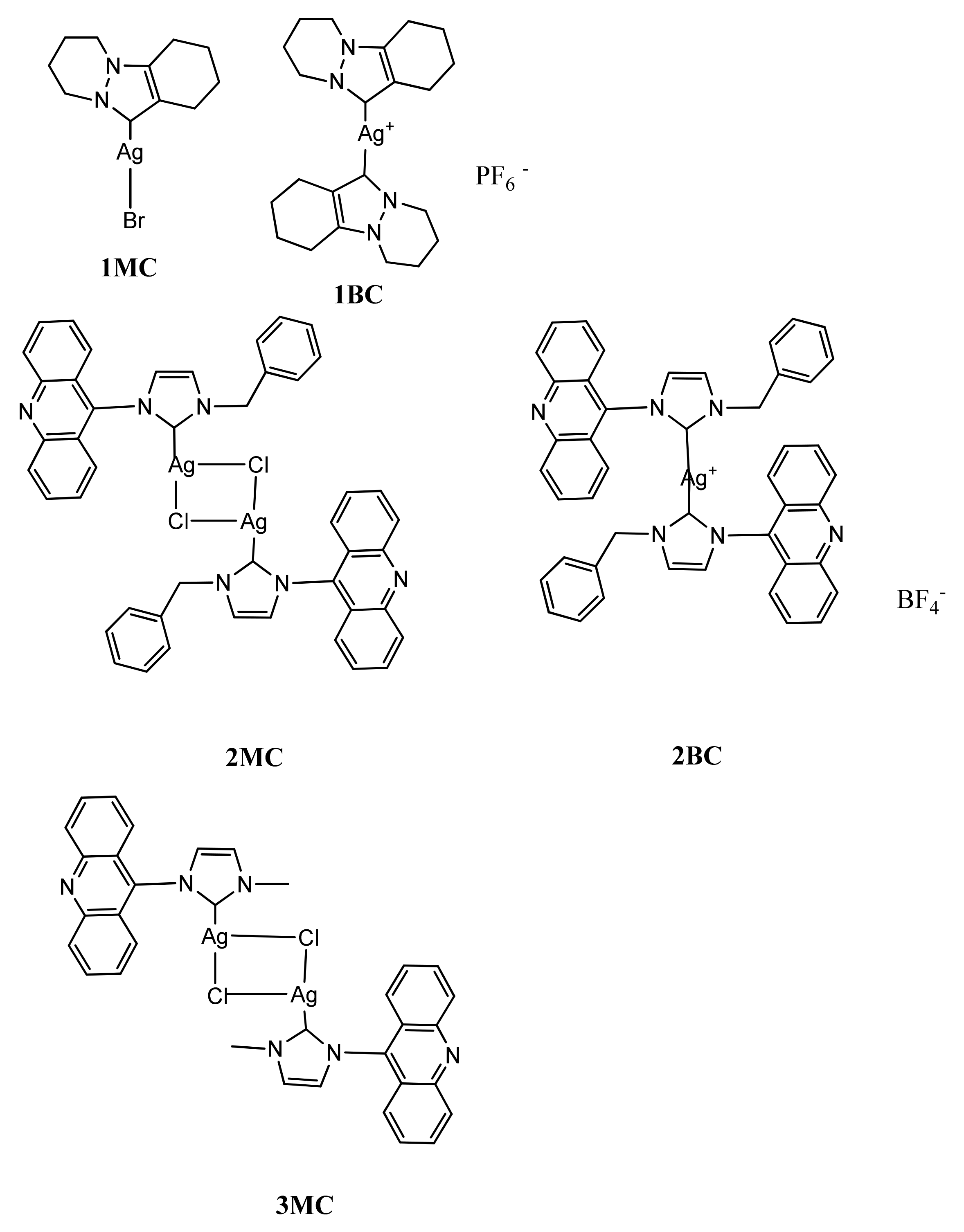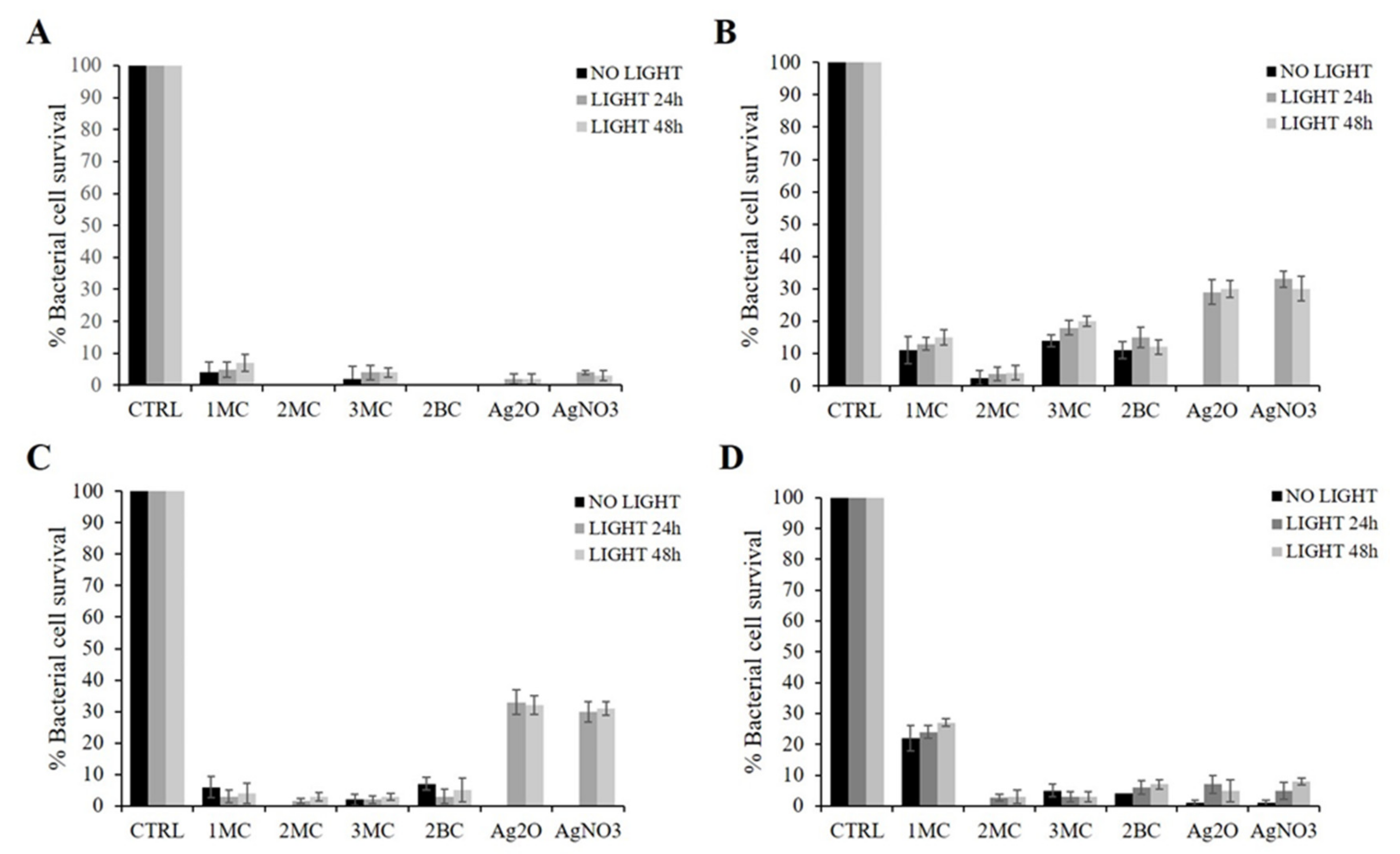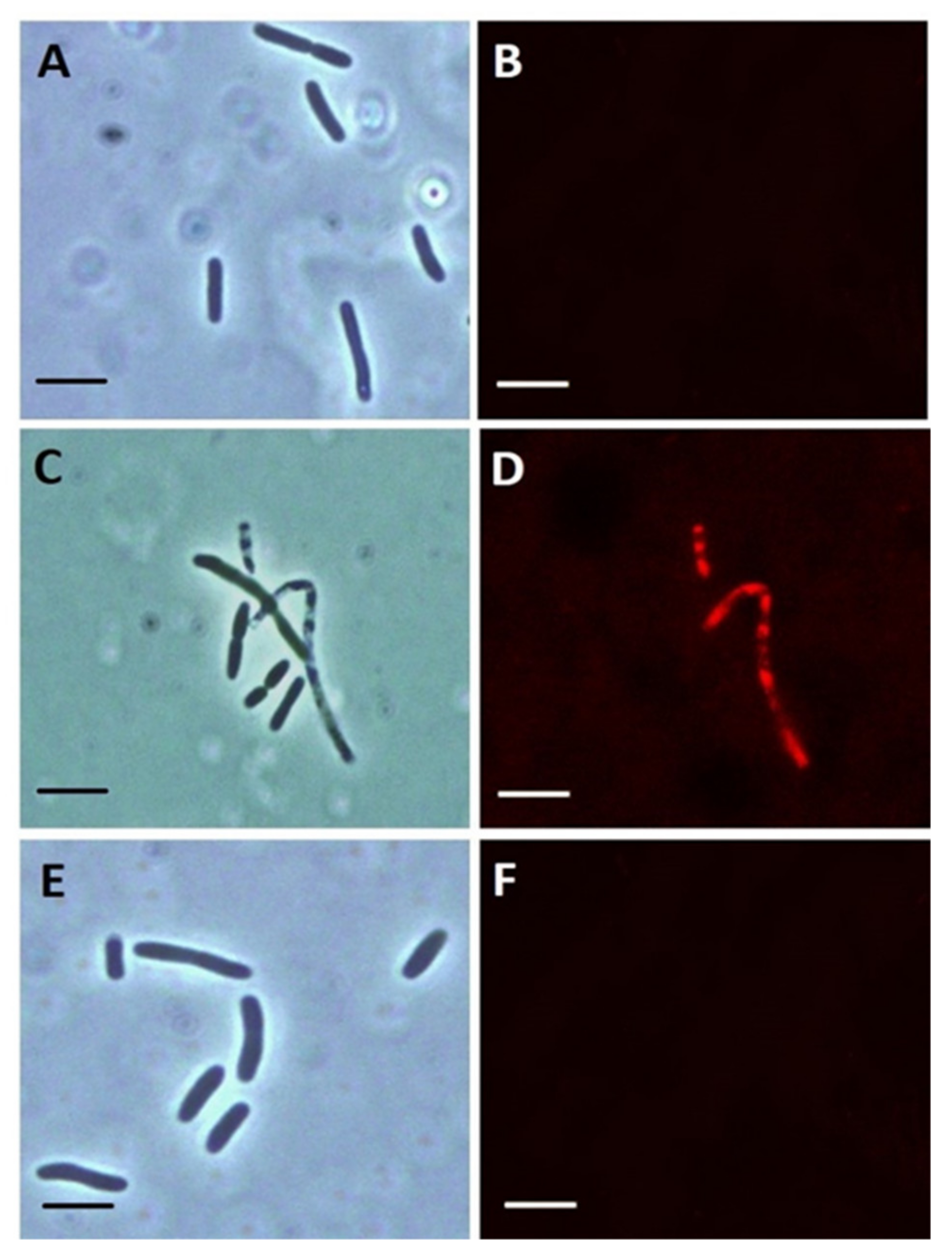Silver (I) N-Heterocyclic Carbene Complexes: A Winning and Broad Spectrum of Antimicrobial Properties
Abstract
1. Introduction
2. Results
2.1. Design and Synthesis
2.2. Biological Assays
3. Discussion
4. Experimental
4.1. Materials and Physicochemical Measurements
4.2. Synthesis of Ligand (1,2,3,4,6,7,8,9-octahydropyridazino [1,2-a]indazolin-11-ylidene), (FPyr·HBr) (1P)
4.3. Synthesis of FpyrAgBr (1MC)
4.4. Synthesis of [(Fpyr)2Ag]BF4 (1BC)
4.5. Minimum Inhibitoryconcentration (MIC)
4.6. Antimicrobial Assays
4.7. Fluorescence Microscopy Image Acquisition
4.8. Eukaryotic Cell Cultures
4.9. Cytotoxicity Assay on Mammalian Cells
5. Conclusions
Supplementary Materials
Author Contributions
Funding
Acknowledgments
Conflicts of Interest
References
- Russel, A.D.; Path, F.R.C.; Hugo, W.B. Antimicrobial activity and action of silver. Prog. Med. Chem. 1994, 31, 351–366. [Google Scholar]
- Moyer, C.A.; Brentanol, L.; Gravens, D.L.; Margraf, H.W.; Monafo, W.W. Treatment of large human burns with 0.5% silver nitrate solution. Arch. Surg. 1965, 90, 812–867. [Google Scholar] [CrossRef]
- Lansdown, A.B.J. Silver I: It’s antibacterial properties and mechanims of action. J. Wound Care 2002, 11, 125–130. [Google Scholar] [CrossRef] [PubMed]
- Kasuga, N.C.; Sugie, A.; Nomiya, K. Syntheses, structures and antimicrobial activities of water-soluble silver(I)–oxygen bonding complexes with chiral and racemic camphanic acid (Hca) ligands. Dalton Trans. 2004, 3732–3740. [Google Scholar] [CrossRef] [PubMed]
- Wells, T.N.C.; Scully, P.; Paravicini, G.; Proudfoot, A.E.I.; Payton, M.A. Mechanism of Irreversible Inactivation of Phosphomannose Isomerases by Silver Ions and Flamazi. Biochemsitry 1995, 34, 7896–7903. [Google Scholar] [CrossRef] [PubMed]
- Melaiye, A.; Simons, R.S.; Milsted, A.; Pingitore, F.; Wesdemiotis, C.; Tessier, C.A.; Youngs, W.J. Formation of Water-Soluble Pincer Silver(I)−Carbene Complexes: A Novel Antimicrobial Agent. Med. Chem. 2004, 47, 973–977. [Google Scholar] [CrossRef] [PubMed]
- Arduengo, A.J., III; Harlow, R.L.; Kline, M. A table crystalline carbene. J. Am. Chem. Soc. 1991, 113, 361–363. [Google Scholar] [CrossRef]
- Herrmann, W.A.; Köcher, C. N-Heterocycliccarbenes. Angew. Chem. Int. Ed. 1997, 36, 2163–2187. [Google Scholar]
- Heinemann, C.; Muller, T.; Apeloig, Y.; Schwarz, H. On the question of stability, conjugation, and “aromaticity” in imidazol-2-ylidenes and their silicon analogs. J. Am. Chem. Soc. 1996, 118, 2023–2038. [Google Scholar] [CrossRef]
- Nolan, S.P. The development and catalytic uses of N-heterocyclic carbene gold complexes. Acc. Chem. Res. 2011, 44, 91–100. [Google Scholar] [CrossRef]
- Romain, C.; Bellemin-Laponnaz, S.; Dagorne, S. Recent progress on NHC-stabilized early transition metal (group 3–7) complexes: Synthesis and applications. Coord. Chem. Rev. 2020, 422, 213411. [Google Scholar] [CrossRef]
- Porchia, M.; Pellei, M.; Marinelli, M.; Tisato, F.; Del Bello, F.; Santini, C. New insights in Au-NHCscomplexesasanticancer agents. Eur. J. Med. Chem. 2018, 146, 709–746. [Google Scholar] [CrossRef] [PubMed]
- Hindi, K.M.; Panzner, M.J.; Tessier, C.A.; Cannon, C.L.; Youngs, W.J. The Medicinal Applications of ImidazoliumCarbene-Metal Complexes. Chem. Rev. 2009, 109, 3859–3884. [Google Scholar] [CrossRef]
- Hussaini, S.Y.; Haquea, R.A.; Razalia, M.R. Recent progress in silver(I)-, gold(I)/(III)- and palladium(II)-N-heterocyclic carbene complexes: A review towards biological perspectives. J. Organomet.Chem. 2019, 882, 96–111. [Google Scholar] [CrossRef]
- Patil, S.A.; Patil, S.A.; Patil, R.; Keri, R.S.; Budagumpi, S.; Balakrishna, G.R.; Tacke, M. N-heterocyclic carbene metal complexes as bio-organometallic antimicrobial and anticancer drugs. Future Med.Chem. 2015, 7, 1305–1333. [Google Scholar] [CrossRef]
- Aher, S.; Das, A.; Muskawar, P.; Osborne, P.; Bhagat, P. Silver (I) complexes of imidazolium basedN-heterocyclic carbene for antibacterial applications. J. Mol. Liquids 2017, 231, 396–403. [Google Scholar] [CrossRef]
- Sharkey, M.A.; O’Gara, J.P.; Gordon, S.P.; Hackenberg, F.; Healy, C.; Paradisi, F.; Patil, S.; Schaible, B.; Tacke, M. Investigations into the Antibacterial Activity of the Silver-Based Antibiotic Drug Candidate SBC3. Antibiotics 2012, 1, 25–28. [Google Scholar] [CrossRef]
- Haque, R.A.; Salman, A.W.; Budagumpi, S.; Abdullah, A.A.; AlMudaris, Z.A.A.; Abdul Majid, A.M.S. Silver(I)-N-heterocyclic carbene complexes ofbis-imidazol-2-ylidenes having different aromatic-spacers: Synthesis, crystal structure, and in vitro antimicrobial and anticancer studies. Appl. Organometal. Chem. 2013, 27, 465–473. [Google Scholar] [CrossRef]
- Gimeno, M.C.; Laguna, A.; Visbal, R.N. Heterocyclic Carbene Coinage Metal Complexes as Intense BlueGreen Emitters. Organometallics 2012, 31, 7146–7157. [Google Scholar] [CrossRef]
- Schuster, O.; Yang, L.; Raubenhaimer, H.G.; Albrect, M. Beyond conventional N-Heterocyclic carbines: Abnormal, remote, and other classes of NHC ligands reduced heteroatom stabilization. Chem. Rev. 2009, 109, 3445–3478. [Google Scholar] [CrossRef]
- Eiter, L.C.; Hall, N.W.; Day, C.S.; Saluta, G.; Kucera, G.L.; Bierbach, U. Gold(I) analogues of a platinum-acridine antitumor agent are only moderately cytotoxic but show potent activity against Mycobacterium tuberculosis. J. Med. Chem. 2009, 52, 6519–6522. [Google Scholar] [CrossRef]
- Scheele, U.J.; Georgiou, M.; John, M.; Dechert, S.; Meyer, F. Combining Pyrazolate and N-Heterocyclic Carbene Coordination Motifs: Synthesis and Characterization of a Double-Crowned Silver Complex. Organometallics 2008, 27, 5146–5151. [Google Scholar] [CrossRef]
- Nebioglu, A.K.; Panzner, M.J.; Tessier, C.A.; Cannon, C.L.; Youngs, W.J. N-Heterocyclic carbene—silver complexes: A new class of antibiotics. Coord. Chem. Rev. 2007, 251, 884–895. [Google Scholar] [CrossRef]
- Chen, C.; Zhou, L.; Xie, B.; Wang, Y.; Ren, L.; Chen, X.; Cen, B.; Lv, H.; Wang, H. Novel fast-acting pyrazole/pyridine-functionalized N-heterocyclic carbene silver complexes assembled with nanoparticles show enhanced safety and efficacy as anticancer therapeutics. Dalton Trans. 2020, 49, 2505–2516. [Google Scholar] [CrossRef] [PubMed]
- Sivaram, H.; Tan, J.; Huynh, H.V. Syntheses, Characterizations, and a Preliminary Comparative Cytotoxicity Study of Gold(I) and Gold(III) Complexes Bearing Benzimidazole- and Pyrazole-Derived N-Heterocyclic Carbenes. Organometallics 2012, 31, 5875–5883. [Google Scholar] [CrossRef]
- Canvas. 3.9 Software; Schrödinger, LLC: New York, NY, USA, 2020. [Google Scholar]
- Ghose, A.K.; Viswanadhan, V.N. Prediction of hydrophobic (lipophilic) properties of small organic molecules using fragmental methods: An analysis of ALOGP and CLOGP methods. J. Phys. Chem. A 1998, 102, 3762–3772. [Google Scholar] [CrossRef]
- Gaglione, R.; Dell’Olmo, E.; Bosso, A.; Chino, M.; Pane, K.; Ascione, F.; Itri, F.; Caserta, S.; Amoresano, A.; Lombardi, A.; et al. Novel human bioactive peptides identified in Apolipoprotein B: Evaluation of their therapeutic potential. Biochem. Pharmacol. 2017, 130, 34–50. [Google Scholar] [CrossRef] [PubMed]
- Pizzo, E.; Varcamonti, M.; Di Maro, A.; Zanfardino, A.; Giancola, C.; D’Alessio, G. Ribonucleases with angiogenic and bactericidal activities from the Atlantic salmon. FEBS J. 2008, 275, 1283–1295. [Google Scholar] [CrossRef]
- Wiegand, I.; Hilpert, K.; Hancock, R.E. Agar and broth dilution methods to determine the minimal inhibitory concentration (MIC) of antimicrobial substances. Nat.Protoc. 2008, 3, 163–175. [Google Scholar] [CrossRef]
- Di Napoli, M.; Di Luccia, B.; Vitiello, G.; D’Errico, G.; Carpentieri, A.; Pezzella, A.; Pizzo, E.; Notomista, E.; Varcamonti, M.; Zanfardino, A. Characterisation of EFV12 a bio-active small peptide produced by the human intestinal isolate Lactobacillusgasseri SF1109. Benef. Microbes 2020, 11, 815–824. [Google Scholar] [CrossRef]
- Vitiello, G.; Melone, P.; Silvestri, B.; Pezzella, A.; Donato, P.; D’Errico, G.; Di Napoli, M.; Zanfardino, A.; Varcamonti, M.; Luciani, G. Titanium based complexes with melanin precursors as a tool for directing melanogenic pathways. Pure Appl. Chem. 2019, 91, 1605–1616. [Google Scholar] [CrossRef]
- Napoli, M.D.; Maresca, V.; Varcamonti, M.; Bruno, M.; Badalamenti, N.; Basile, A.; Zanfardino, A. (+)-(E) Chrysanthenyl acetate: A molecule with interestingbiologicalpropertiescontained in the Anthemissecundiramea (asteraceae) flowers. Appl. Sci. 2020, 10, 6808. [Google Scholar] [CrossRef]
- Zanfardino, A.; Bosso, A.; Gallo, G.; Pistorio, V.; Di Napoli, M.; Gaglione, R.; Dell’Olmo, E.; Varcamonti, M.; Notomista, E.; Arciello, A.; et al. Humanapolipoprotein E as a reservoir of crypticbioactivepeptides: The case of ApoE 133–167. J. Pept. Sci. 2018, 24, e3095. [Google Scholar] [CrossRef] [PubMed]





| Complexes | Log p |
|---|---|
| 1MC | 2.21 |
| 2MC | 8.66 |
| 3MC | 5.60 |
| 1BC | 4.41 |
| 2BC | 8.87 |
| E. coli DH5α | P. aeruginosa PAOI | B. subtilis PY79 | S. aureus 6538P | ||||
|---|---|---|---|---|---|---|---|
| Compound | MIC[μM] | Compound | MIC[μM] | Compound | MIC[μM] | Compound | MIC[μM] |
| 1P | >50 | 1P | >50 | 1P | >50 | 1P | >50 |
| 2P | >50 | 2P | >50 | 2P | >50 | 2P | >50 |
| 3P | >50 | 3P | >50 | 3P | >50 | 3P | >50 |
| 1MC | 5 | 1MC | 10 | 1MC | 10 | 1MC | 10 |
| 2MC | ≤1 | 2MC | ≤1 | 2MC | ≤1 | 2MC | ≤1 |
| 3MC | ≤1 | 3MC | ≤1 | 3MC | ≤1 | 3MC | ≤1 |
| 1BC | 25 | 1BC | 40 | 1BC | 40 | 1BC | 50 |
| 2BC | ≤1 | 2BC | ≤1 | 2BC | ≤1 | 2BC | ≤1 |
| Ag2O | ≤1 | Ag2O | ≤1 | Ag2O | ≤1 | Ag2O | ≤1 |
| AgNO3 | ≤1 | AgNO3 | ≤1 | AgNO3 | ≤1 | AgNO3 | ≤1 |
Publisher’s Note: MDPI stays neutral with regard to jurisdictional claims in published maps and institutional affiliations. |
© 2021 by the authors. Licensee MDPI, Basel, Switzerland. This article is an open access article distributed under the terms and conditions of the Creative Commons Attribution (CC BY) license (http://creativecommons.org/licenses/by/4.0/).
Share and Cite
Prencipe, F.; Zanfardino, A.; Di Napoli, M.; Rossi, F.; D’Errico, S.; Piccialli, G.; Mangiatordi, G.F.; Saviano, M.; Ronga, L.; Varcamonti, M.; et al. Silver (I) N-Heterocyclic Carbene Complexes: A Winning and Broad Spectrum of Antimicrobial Properties. Int. J. Mol. Sci. 2021, 22, 2497. https://doi.org/10.3390/ijms22052497
Prencipe F, Zanfardino A, Di Napoli M, Rossi F, D’Errico S, Piccialli G, Mangiatordi GF, Saviano M, Ronga L, Varcamonti M, et al. Silver (I) N-Heterocyclic Carbene Complexes: A Winning and Broad Spectrum of Antimicrobial Properties. International Journal of Molecular Sciences. 2021; 22(5):2497. https://doi.org/10.3390/ijms22052497
Chicago/Turabian StylePrencipe, Filippo, Anna Zanfardino, Michela Di Napoli, Filomena Rossi, Stefano D’Errico, Gennaro Piccialli, Giuseppe Felice Mangiatordi, Michele Saviano, Luisa Ronga, Mario Varcamonti, and et al. 2021. "Silver (I) N-Heterocyclic Carbene Complexes: A Winning and Broad Spectrum of Antimicrobial Properties" International Journal of Molecular Sciences 22, no. 5: 2497. https://doi.org/10.3390/ijms22052497
APA StylePrencipe, F., Zanfardino, A., Di Napoli, M., Rossi, F., D’Errico, S., Piccialli, G., Mangiatordi, G. F., Saviano, M., Ronga, L., Varcamonti, M., & Tesauro, D. (2021). Silver (I) N-Heterocyclic Carbene Complexes: A Winning and Broad Spectrum of Antimicrobial Properties. International Journal of Molecular Sciences, 22(5), 2497. https://doi.org/10.3390/ijms22052497








